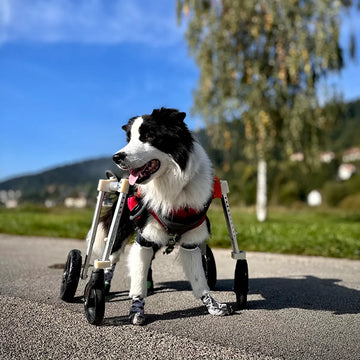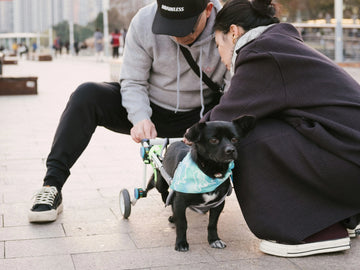It’s heartbreaking to watch your dog begin to stumble, drag their legs, or lose the confidence to go outside. These moments are painful, but they don’t have to mean the end of your dog’s active life.
Thanks to advancements in veterinary mobility aids, a wheelchair for dogs has become a practical and life-changing solution — not only for severely disabled dogs, but for any pet facing mobility challenges. Once seen as a last resort, dog wheelchairs are now widely recommended by vets as early intervention tools to help dogs maintain strength, independence, and dignity.

I. Why Might a Dog Need a Wheelchair for Dogs?
Dogs may face mobility issues for various reasons—injury, neurological conditions, breed predisposition, or aging. A wheelchair for dogs supports them by offloading weight from affected limbs, improving their quality of life. Common conditions benefiting from a wheelchair include:
-
Degenerative Myelopathy (DM): Progressive spinal disease that weakens hind legs and eventually affects all limbs — Cornell Veterinary Center notes early symptoms like wobbling and hind-leg weakness.
-
Intervertebral Disc Disease (IVDD): Especially common in Dachshunds and Corgis, causing rear-leg paralysis if untreated.

-
Hip Dysplasia & Osteoarthritis: Painful joint degeneration, especially in larger breeds.
-
Post-surgical Recovery: Assistance after spinal or orthopedic surgeries.
-
Trauma and nerve damage: From accidents or falls.
-
Age-related muscle loss (sarcopenia): Hindermost legs weaken naturally with age.
Early use of a wheelchair for dogs helps preserve muscle tone, reduce pain, and prevent further injury.
II. How Do You Know If Your Dog Needs a Wheelchair for Dogs?
Dog wheelchairs aren't just for complete paralysis. In fact, early use can slow deterioration. Signs your dog may benefit include:
-
Difficulty standing or hesitation in rising
-
Rear-leg dragging, knuckling, or crossing
-
Frequent slipping or stumbling
-
Refusal to climb stairs or go on long walks
-
Noticeable loss of muscle in hindquarters
-
Diagnosed spinal, joint, or nerve conditions
-
Behavioural changes: withdrawal, anxiety, or lethargy
If any of this sounds familiar, a wheelchair for dogs might help preserve your dog’s mobility and wellbeing.

III. How Does a Wheelchair for Dogs Actually Work?
A wheelchair for dogs shifts weight from weak limbs to a stable frame and wheels. Common types include:
-
Rear-support carts: Assist dogs with hind-leg weakness
-
Full-support (quad) carts: Aid all four limbs, often for neurological or post-op cases
-
Front-support carts: Rare but helpful for forelimb issues

High-quality models are built with:
-
Adjustable aluminum frame
-
Padded harnesses and straps to prevent rubbing
-
All-terrain wheels for indoor and outdoor use
-
Open rear design for natural elimination
IV. Do Dogs Really Benefit from a Wheelchair for Dogs?

Yes — owners and veterinarians report considerable improvements:
-Restored mobility and exercise capacity
-Better urinary and digestive function due to proper posture
-Less pain and fewer falls
-Preserved muscle mass
-Elevated mood and engagement
Similarly, observational research from the University of Ljubljana reported high owner satisfaction, with 5 out of 8 dog owners describing the experience as very positive.
V. Pawsbetter Wheelchairs for Dogs: Thoughtful, Affordable, Effective
At Pawsbetter, our three wheelchair models are designed for real-world canine needs:
-
Dog Wheelchair for Back Legs– from £79
-
Full-Support Wheelchair – from £129
-
Small & Medium Dog Wheelchair – from £49
We offer:
-
✅ 30‑day returns & size exchanges
-
✅ Personalized sizing guidance
-
✅ 180‑day warranty with free replacement parts
Every wheelchair we make aims to restore freedom—for dogs and their families.
👉 Explore our wheelchair for dogs collection
VI. A Wheelchair for Dogs Marks a New Beginning
Seeing your dog regain balance, tail wagging happily, is unforgettable. A wheelchair for dogs may look like assistance, but what it truly offers is freedom, hope, and renewed joy.
Choosing a dog wheelchair isn’t giving up — it’s standing by them, ensuring they continue to share every moment of life with you.
This article is for informational purposes only and is not a substitute for professional veterinary advice.




